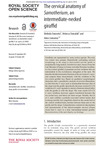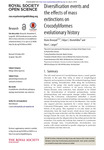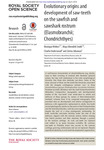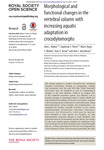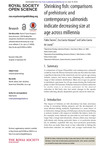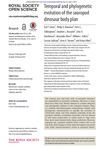Browsing by Subject "Palaeontology"
Now showing items 1-20 of 23
-
An advanced shape-fitting algorithmapplied to quadrupedal mammals
(2015)Body mass is a fundamental physical property of an individual and has enormous bearing upon ecology and physiology. Generating reliable estimates for body mass is therefore a necessary step in many palaeontological studies. ... -
Baleen boomand bust
(The Royal Society, 2015)A new, fully dated total-evidence phylogeny of baleen whales (Mysticeti) shows that evolutionary phases correlate strongly with Caenozoic modernization of the oceans and climates, implying a major role for bottom-up physical ... -
Bone flute descriptions
(The Royal Society, 2015)Punctured extinct cave bear femora were misidentified in southeastern Europe (Hungary/Slovenia) as ‘Palaeolithic boneflutes’ and the ‘oldest Neanderthal instruments’. These are not instruments, nor human made, but products ... -
The cervical anatomy of Samotherium,an intermediate-necked giraffid
(2015)Giraffidae are represented by many extinct species. The only two extant taxa possess diametrically contrasting cervical morphology, as the okapi is short-necked and the giraffe is exceptionally long-necked.Samotherium ... -
Diversification events and the effects of mass extinctions on Crocodyliformes evolutionary history
(2015)The rich fossil record of Crocodyliformes shows a much greater diversity in the past than today in terms of morphological disparity and occupation of niches. We conducted topology-based analyses seeking diversification ... -
Egg shape changes at the theropod bird transition, and amorphometric study of amniote eggs
(2014)The eggs of amniotes exhibit a remarkable variety of shapes, from spherical to elongate and from symmetrical to asymmetrical. We examine eggshell geometry in a diverse sample of fossil and living amniotes using geometric ... -
Estimating cranial musculoskeletal constraints in theropod dinosaurs
(2015)Many inferences on the biology, behaviour and ecology of extinct vertebrates are based on the reconstruction of the musculature and rely considerably on its accuracy. Although the advent of digital reconstruction techniques ... -
Evolutionary origins and development of saw-teeth on the sawfish and sawshark rostrum
(2015)A well-known characteristic of chondrichthyans (e.g. sharks, rays) is their covering of external skin denticles (placoid scales), but less well understood is the wide morphological diversity that these skin denticles can ... -
First report of Plesiochelys etalloniandTropidemys langiifrom the Late Jurassic of the UK and the palaeobiogeography of plesiochelyid turtles
(2016)Plesiochelyidae is a clade of relatively large coastal marine turtles that inhabited the shallow epicontinental seas that covered western Europe during the Late Jurassic. Although the group has been reported from many ... -
Life history of the most complete fossil primate skeleton
(The Royal Society, 2015)Darwiniusis an adapoid primate from the Eocene of Germany, and its only known specimen represents the most complete fossil primate ever found. Its describers hypothesized a close relationship to Anthropoidea, and using a ... -
Mitigating the Goldilocks effect
(2014)In ichnology, the Goldilocks effect describes a scenario in which a substrate must be ‘just right’ in order for tracks to form—too soft, the animal will be unable to traverse the area, and too firm, the substrate will not ... -
Morphological and functional changes in the vertebral columnwith increasing aquatic adaptation in crocodylomorphs
(2015)The lineage leading to modern Crocodylia has undergone dramatic evolutionary changes in morphology, ecology and locomotion over the past 200+Myr. These functional innovations may be explained in part by morphological changes ... -
A new Early Oligocene toothed ‘baleen’ whale from western North America
(2015)Archaic toothed mysticetes represent the evolutionary transition from raptorial to bulk filter feeding in baleen whales. Aetiocetids, in particular, preserve an intermediate morphological stage in which teeth functioned ... -
Peculiar macrophagous adaptations in a new Cretaceous pliosaurid
(2015)During the Middle and Late Jurassic, pliosaurid plesiosaurs evolved gigantic body size and a series of craniodental adaptations that have been linked to the occupation of an apex predator niche. Cretaceous pliosaurids (i.e. ... -
The relationships of the Euparkeriidae and the rise of Archosauria
(2016)For the first time, a phylogenetic analysis including all putative euparkeriid taxa is conducted, using a large data matrix analysed with maximum parsimony and Bayesian analysis. Using parsimony, the putative euparkeriidDorosuchus ... -
Revision of the Late Jurassic teleosaurid genus Machimosaurus
(2014)Machimosaurus was a large-bodied genus of teleosaurid crocodylomorph, considered to have been durophagous/ chelonivorous, and which frequented coastal marine/estuarine ecosystems during the Late Jurassic. Here, we revise ... -
Shrinking fish: comparisons of prehistoric and contemporary salmonids indicate decreasing size at age across millennia
(The Royal Society, 2014)A comparison of Upper Palaeolithic and contemporary salmonid vertebrae from the Iberian Peninsula indicates that there has been a significant decrease in the mean body size for a given age among Atlantic salmon and brown ... -
Surface drag reduction and flow separation control in pelagic vertebrates
(2015)Living in water imposes severe constraints on the evolution of the vertebrate body. As a result of these constraints, numerous extant and extinct aquatic vertebrate groups evolved convergent osteological and soft-tissue ... -
Temporal and phylogenetic evolution of the sauropod dinosaur body plan
(2016)The colossal size and body plan of sauropod dinosaurs are unparalleled in terrestrial vertebrates. However, to date, there have been only limited attempts to examine temporal and phylogenetic patterns in the sauropod ... -
Tiarajudens eccentricus and Anomocephalus africanus, two bizarre anomodonts (Synapsida, Therapsida) with dental occlusion from the Permian of Gondwana
(The Royal Society, 2015)Anomodontia was a highly successful tetrapod clade during the Permian and the Triassic. New morphological information regarding two bizarre basal anomodonts is provided and their palaeoecological significance is explored. ...




